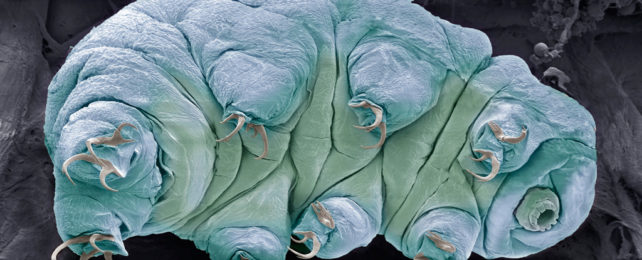Tiny, weirdly adorable creatures called tardigrades are one of the toughest organisms on Earth.
Tardigrades, which are perhaps better known as water bears because of their plump bodies, belong to an extremely resilient group of microorganisms that can thrive in harsh environments ill-suited for life.
In order to survive, they squeeze water from their bodies and roll into dehydrated balls known as tuns.
While in this form, tardigrades can withstand the most extreme environments — even the vacuum of space.
As a tun, these microscopic critters can go years without food or water and endure extreme radiation and temperatures.
That hardy nature makes them the perfect test subjects in experiments about the tenacity of life.
From being shot out of a gun to crash-landing on the moon, these are five notable times tardigrades proved their mettle in the name of science.
1. Water-dwelling tardigrades became space-faring test subjects
Scientists hope to find out what makes these little creatures nearly indestructible. They really are small — they range from 100 to 1,000 microns in size, as small as the height of a sheet of paper.
In 2021, NASA sent 5,000 tardigrades into space in a cargo resupply mission to the International Space Station. "We want to see what 'tricks' they use to survive when they arrive in space, and, over time, what tricks their offspring are using," Thomas Boothby, principal investigator of the experiment, said in a NASA statement.
In 2007, a European team of researchers sent 3,000 tardigrades to orbit the earth on the outside of a spacecraft for 12 days. When the water bears returned to Earth, the scientists discovered that 68 percent survived.
"Our principle finding is that the space vacuum, which entails extreme dehydration and cosmic radiation, were not a problem for water bears," Ingemar Jönsson, the project leader for the European experiment, said in a statement.
2. Tardigrades crash-landed on the moon
In April 2019, an Israeli lunar probe crashed into the moon while carrying thousands of dehydrated tardigrades on board.
Many speculated the water bears might have survived the crash. "We believe the chance of survival for the tardigrades are extremely high," Nova Spivack, co-founder of the organization that put the tardigrades in space, told BBC News.
According to Wired, any tardigrade found in the future would have to be brought back to Earth to be rehydrated on a planet with an atmosphere.
3. A thawed tardigrade survived being frozen for 3 decades
In 2016, scientists at Japan's National Institute of Polar Research examined tardigrades retrieved from a frozen moss sample collected in Antarctica in 1983.
After rehydrating them, researchers successfully revived a tardigrade that had been frozen for more than 30 years. What's more, researchers found tardigrades can successfully reproduce after decades in frigid conditions.
Based on laboratory experiments, tardigrades even survive at -458 degrees Fahrenheit. That's more than twice as cold as the coldest temperature that was ever observed on Earth's surface, according to NASA.
4. The creatures endured scorching temperatures
Tardigrades can survive in extremely hot temperatures, and you'll find them in some of Earth's most extreme environments like deep sea vents, hot springs, and mud volcanoes.
Still, in a 2020 study, researchers found that long-term exposure to high temperatures, even in their hibernated state, can kill tardigrades in only a day. In the study, after being exposed to water temperatures of about 100 degrees Fahrenheit, half of the tardigrades in the research sample died.
"We had found their Achilles' heel," Ricardo Neves, lead researcher of the study, told Newsweek.
5. Tardigrades survived being shot out of a high-speed gun
Some scientists believe that tardigrades may be capable of spreading life to different planets.
In a 2021 study, researchers loaded a nylon bullet with tardigrades in a state of hibernation and fired them into a sand target at a range of speeds. The critters survived smashing into targets at speeds up to about 2,000 mph, but the ones that were shot at faster speeds blew apart on impact.
They wanted to test if a tardigrade could survive a cosmic impact, such as a meteorite landing on Earth, since it would give credence to the idea that life might be able to hitchhike its way across the cosmos.
"If they could do it and they're the hardest thing we know, right? Maybe other things can," said Mark Burchell, supervisor on the experiment, said in a press release. "[B]ut if they can't do it, and they're the hardest thing we know, then maybe nothing else can either."
This article was originally published by Business Insider.
More from Business Insider: